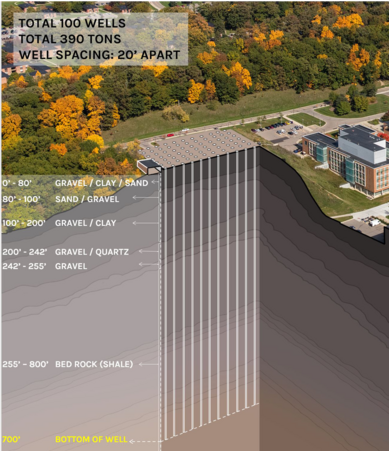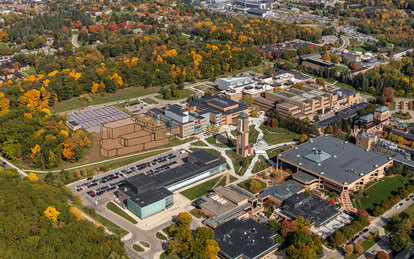University of Michigan Hayward Street Geothermal Facility
Storing and retrieving waste heat from deep underground, a geoexchange facility at the University of Michigan marks a promising new alternative to fossil fuels for heating and cooling campus buildings.
Client
University of Michigan
Location
Ann Arbor, Michigan
Markets/Services
Architecture, Civil Engineering, Energy & Environmental Modeling, Green Infrastructure, Higher Education, MEP Engineering, Structural Engineering, Sustainable Design
Forthright in its commitment to climate action, sustainability, and environmental justice, the University of Michigan (U-M) is nearing its goal to achieve carbon neutrality by 2040. In conjunction with plans for onsite renewable energy, the university aims to decarbonize the Ann Arbor campus’s heating and cooling infrastructure with electric heat pumps and geoexchange. SmithGroup provided engineering and architecture services for the university’s first campus-scale geoexchange plant in partnership with geothermal consultant, Strategic Energy Solutions.
The Hayward Street Geothermal Facility is a groundbreaking project that will heat and cool the new 163,000-square-foot Leinweber Computer Science and Information Building, with the ability to extend low temperature heating hot water to existing buildings on U-M's North Campus . Instead of relying on natural gas, this building will engage heat pumps that take heat from the building in the summer, store it underground, and then retrieve the heat to warm the building in the winter. This approach is an ideal fit for the University of Michigan, given its cold climate, broad building typologies, and diverse energy demands. University leaders view the project as an important step in evaluating the effectiveness of geothermal—also called geoexchange—systems and charting the way for other academic institutions around the world.

The Hayward Street geothermal field is an underground closed-loop system of more than 13 miles of piping. The bores run as deep as 700 feet and cover an area about two-thirds the size of a football field. Drilling to those depths maximizes heat transfer and storage capacity in Michigan’s climate, where sub-surface temperatures average 50 degrees Fahrenheit year-round. When complete,
The geothermal field will be hidden from view, capped with a surface parking lot. The 4,000-square-foot Geothermal Facility houses the central heat pumps and water distribution pumps, which can also interconnect with future geothermal fields as they are needed.
In addition to the Hayward Street project, the university is also moving forward with a geoexchange system to heat and cool portions of a Central Campus residential complex and a third project that will serve the 11,000-square-foot Edward and Rosalie Ginsberg Building. Not only is geothermal exchange a promising technology for widespread use, but the University of Michigan is also demonstrating that it is an immediately actionable step that universities can take to reshape their energy future.
